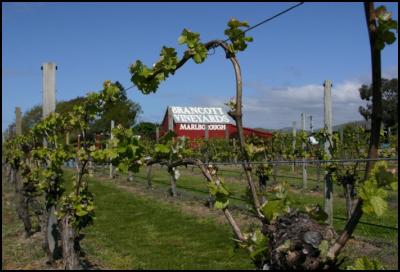Strong budburst for Montana’s 2009 grape harvest
28 October 2008
Strong budburst
positive for Montana’s 2009 grape
harvest

While it is too early to make predictions for next year’s vintage, Montana’s viticulturists are very satisfied with budburst - the first crucial stage in the lead-up to the grape harvest. Budburst and spring shoot growth is now well advanced in all the winegrowing regions of New Zealand.
“The mild, dry spring is good news for vineyards, especially after the extremely wet winter in some parts of the country,” says Mike Insley, Montana’s national vineyards manager. Montana has vineyards in all five major winegrowing regions of New Zealand.
So far, the season is running about a week early in the North Island and upper South Island. In Central Otago, vine development is close to normal, slightly behind last year’s unusually warm season.
In Gisborne, budburst has been strong and even. So far, the spring frosts have been relatively mild, though helicopters had to be called upon on a few occasions to stir up cold air layers.
Hawke’s Bay has also had a strong, even bud push. Some parts of the region experienced damaging frosts at the end of September, although not to the same extent as last year. Extended protection such as frost fans proved effective in limiting damage to the vines on Montana’s vineyards.
A warm, dry October has helped both Marlborough and Waipara dry out after a very wet winter. Wells and aquifer levels have fully recovered after the last dry season and soil moisture levels are good.
“The healthy vine canopies at the end of the 2008 harvest allowed us to retain some great wood after pruning, laying the foundation for a good budburst,” says Mike. “We’re already seeing higher than usual cluster numbers on new Sauvignon Blanc shoots, although it is early days to be making any yield predictions.”
Budburst is progressing well in Central Otago, with the new season’s shoots now fully emerged in all areas. After a dry, cold winter some parts of the region have received over 70mm of welcome rain in spring. As well as being essential for vine growth, the rain helps to reduce frost risk, as damp, bare earth absorbs and retains the sun’s heat better than dry ground.
With the good budburst, Montana has now started with shoot thinning on vines destined to produce the highest quality wines. “Shoot thinning is the next step after pruning in fine-tuning the vines to ensure we get appropriate yields, canopy density and evenness of growth for our top-quality wines,” says Mike.
The next critical stage in vine development is flowering in December. The major risk factor between now and then is that damaging frosts can occur until the end of November in many regions of New Zealand.
“We watch out for strong southerly fronts which may bring frosty conditions. Hard frosts at this time of year can damage the new growing shoot, causing crop loss and uneven growth,” says Mike. “However, with each passing year we increase the level of frost protection on our vineyards, which reduces the risk.”
Every improvement in vineyard management helps Montana to produce better wines. “As winemakers, we know that good wine is made in the vineyard,” says Mike.
ENDS


 Insurance Council of New Zealand: Insurers Support Kiwis As Severe Weather Eases
Insurance Council of New Zealand: Insurers Support Kiwis As Severe Weather Eases Science Media Centre: What Goes Into Making Our Seasonal Flu Jab? – Expert Q+A
Science Media Centre: What Goes Into Making Our Seasonal Flu Jab? – Expert Q+A The Document Foundation: Celebrating 20 Years Of The OASIS Open Document Format (ODF) Standard
The Document Foundation: Celebrating 20 Years Of The OASIS Open Document Format (ODF) Standard Maritime Union of New Zealand: Maritime Union Raises Serious Concerns Over Aratere Ferry Removal
Maritime Union of New Zealand: Maritime Union Raises Serious Concerns Over Aratere Ferry Removal Ferry Holdings Limited: Decommissioning Of The Aratere Ferry
Ferry Holdings Limited: Decommissioning Of The Aratere Ferry Broadcasting Standards Authority: Inaccurate 1News Reporting On Football Violence Breached Broadcasting Standards
Broadcasting Standards Authority: Inaccurate 1News Reporting On Football Violence Breached Broadcasting Standards